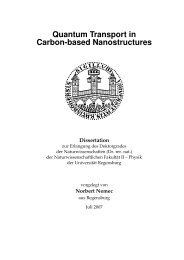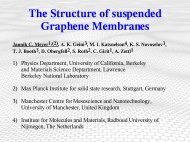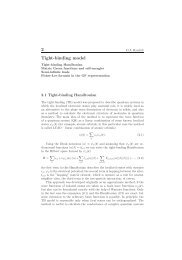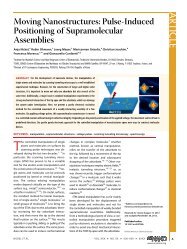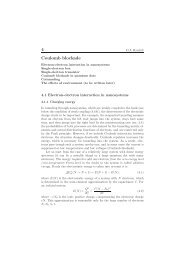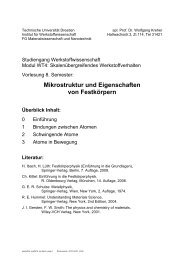Efficient linear scaling method for computing the thermal conductivity ...
Efficient linear scaling method for computing the thermal conductivity ...
Efficient linear scaling method for computing the thermal conductivity ...
Create successful ePaper yourself
Turn your PDF publications into a flip-book with our unique Google optimized e-Paper software.
LI, SEVINÇLI, ROCHE, AND CUNIBERTI PHYSICAL REVIEW B 83, 155416 (2011)<br />
PDOS (arbitrary unit)<br />
a n<br />
b n<br />
0 20 40 60 80 100<br />
Recursion number n<br />
0 200 400 600 800 1000 1200 1400 1600<br />
ω (cm −1 )<br />
FIG. 1. (Color online) Vibrational PDOS on a single random<br />
phase state <strong>for</strong> a clean two-dimensional graphene system calculated<br />
by using <strong>the</strong> <strong>for</strong>ce constants given in Ref. 53. The Lanczos coefficients<br />
are shown in <strong>the</strong> inset.<br />
In practice, <strong>the</strong> continued fraction is terminated after a certain<br />
step N by <strong>the</strong> approximation aN+1 = a∞ and bN+1 = b∞.The<br />
termination can be analytically obtained as<br />
(ω) = ω2 + iη − a∞ − i (2b∞) 2 − (ω2 + iη − a∞) 2<br />
.<br />
2b 2 ∞<br />
(24)<br />
As an example, <strong>the</strong> normal PDOS on a single random phase<br />
state <strong>for</strong> a clean two-dimensional graphene system is given in<br />
Fig. 1. It already agrees well with <strong>the</strong> DOS obtained by direct<br />
matrix diagonalization. The inset shows <strong>the</strong> corresponding<br />
Lanczos coefficients, a(n) and b(n).<br />
C. Chebyshev polynomial expansion<br />
The evolution of <strong>the</strong> vector [X,U(t)]|ψ〉 is determined by<br />
U(t). Although U(t) has a simple <strong>for</strong>m, its exact calculation<br />
requires diagonalization of <strong>the</strong> dynamical matrix. Provided<br />
that all <strong>the</strong> eigenvalues and eigenvectors of D are known,<br />
<strong>the</strong> matrix <strong>for</strong>m of U(t) can be obtained by using a unitary<br />
trans<strong>for</strong>mation. The diagonalization of a matrix requires<br />
O(N 3 ) operations, so it is practically impossible to handle a<br />
system with size N 10 6 . One can employ Taylor expansion,<br />
but <strong>the</strong> efficiency and <strong>the</strong> accuracy are difficult to fulfill at<br />
<strong>the</strong> same time with such an expansion, especially because<br />
higher accuracy requires ei<strong>the</strong>r a larger number of time steps or<br />
larger expansion orders <strong>for</strong> a given time t. The implementation<br />
of <strong>the</strong> Taylor expansion <strong>for</strong> studying long time propagation<br />
of wave packets in large-scale disordered systems with high<br />
accuracy is <strong>the</strong>re<strong>for</strong>e beyond today’s computational reach.<br />
Instead, we use orthogonal polynomials. In principle, any set of<br />
orthogonal polynomials could be used <strong>for</strong> expanding <strong>the</strong> time<br />
evolution operator. On <strong>the</strong> o<strong>the</strong>r hand, Chebyshev polynomials<br />
have been widely used in past literature due to a particularly<br />
well achieved numerical stability, 20,38 and <strong>for</strong> this reason<br />
we employ <strong>the</strong> Chebyshev polynomial expansion approach.<br />
Formally, one can expand any function of an operator in<br />
terms of Chebyshev polynomial-based operators, since <strong>the</strong> set<br />
of Chebyshev polynomials Qn <strong>for</strong>m a complete orthogonal<br />
basis set. The expansion coefficients depend on <strong>the</strong> <strong>for</strong>m<br />
of <strong>the</strong> expanded function, on <strong>the</strong> time step t, and on <strong>the</strong><br />
function domain [a − 2b,a + 2b], which should cover <strong>the</strong><br />
whole spectrum of <strong>the</strong> dynamical matrix D. Since Chebyshev<br />
polynomials are defined in <strong>the</strong> interval [−1,1], we first need<br />
to scale and shift <strong>the</strong> argument so that it falls within <strong>the</strong> range<br />
based on D ′ = (D − a)/2b. Finally, U(t) can be expanded<br />
as<br />
where<br />
cn(t) =<br />
U(t) = e −it√ a+2bD ′<br />
1 2<br />
π(1 + δn,0) −1<br />
=<br />
∞<br />
cn(t)Qn(D ′ ), (25)<br />
n=0<br />
dx ′ 1<br />
√<br />
1 − x ′2 e−it√ a+2bx ′<br />
Qn(x ′ ).<br />
(26)<br />
Thus, [X,U(t)]|ψ〉 = ∞<br />
n=0 cn(t)[X,Qn(D)]|ψ〉. Then<br />
<strong>the</strong> commutators are computed using <strong>the</strong> Chebyshev recurrence<br />
relation bQn+1(D ′ ) = (D − a)Qn(D ′ ) − bQn−1(D ′ ),<br />
where Q0(D ′ ) = 1 and Q1(D ′ ) = (D − a)/2b. Recurrence<br />
relations between commutators write b[X,Qn+1(D ′ )] =<br />
[X,(D − a)Qn(D ′ )] − b[X,Qn−1(D ′ )], which is rewritten <strong>for</strong><br />
convenience as<br />
|αn〉 =Qn(D ′ )|ψ〉, |βn〉 =[X,Qn(D ′ )]|ψ〉. (27)<br />
Using <strong>the</strong> well-known expression [A,BC] = [A,B]C +<br />
B[A,C], <strong>the</strong> commutator relationship becomes b|βn+1〉 =<br />
(D − a)|βn〉−b|βn−1〉+[X,D]|αn〉 with |β0〉 =0 and<br />
|β1〉 =[X,D]|ψ〉/2b. The computation of |βn〉 requires <strong>the</strong><br />
knowledge of vectors |αn〉 =Qn(D ′ )|ψ〉 that appear in <strong>the</strong><br />
Chebyshev expansion of <strong>the</strong> evolution operator U(T )|ψ〉.<br />
Such |αn〉 vectors satisfy<br />
b|αn+1〉 =(D − a)|αn〉−b|αn−1〉, (28)<br />
with |α0〉 =|ψ〉 and |α1〉 =(D − a)|ψ〉/2b. The algorithm<br />
thus consists of <strong>computing</strong> in parallel two recurrence relations<br />
and summing up <strong>the</strong> series:<br />
and<br />
Npoly <br />
U(t)|ψ〉 = cn(t)|αn〉 (29)<br />
n=0<br />
Npoly <br />
[X,U(t)]|ψ〉 = cn(t)|βn〉. (30)<br />
n=0<br />
To reach <strong>the</strong> desired accuracy, <strong>the</strong> number of recursion steps<br />
(Npoly) needs to be chosen appropriately depending on <strong>the</strong><br />
evolution step and <strong>the</strong> spectral bandwidth. Once U(mt)|ψ〉<br />
and [X,U(mt)]|ψ〉 are obtained at time mt, <strong>the</strong>n <strong>for</strong> <strong>the</strong><br />
following evolution step one has<br />
and<br />
155416-4<br />
U((m + 1)t)|ψ〉 =[X,U(t)]U(mt)]|ψ〉 (31)<br />
[X,U((m + 1)t)]|ψ〉 =[X,U(t)]U(mt)|ψ〉<br />
+ U(t)[X,U(mt)]|ψ〉. (32)





